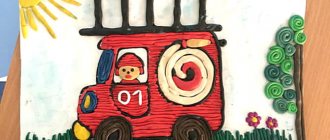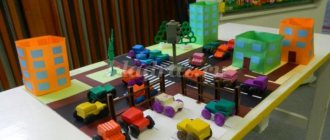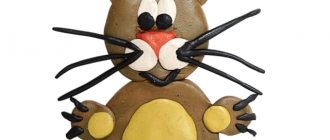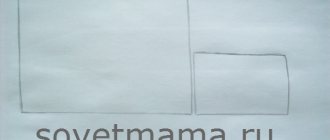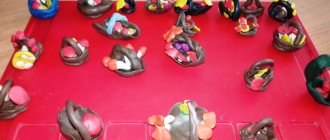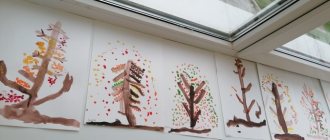Features of organizing modeling classes in the middle group of preschool educational institutions
Current types of modeling
Children 4–5 years old find it easier to work with plasticine; their stronger muscles make it easy to tear off and knead the material. Although there remain difficulties with sculpting small parts and connecting parts of an object to each other (without flattening), the crafts are already quite similar to real objects and have certain proportions. With each lesson, preschoolers' skills improve.
Creating a fish refers to object modeling. Preschoolers generally love to sculpt animals and people - objects that they can later play with (and not just admire). Although, it should be noted, the depiction of plant-shaped objects is easier for them.
Since pupils in the middle group do not yet have a clear idea of the structure of the body of a living creature, the teacher’s task is to teach children to display the key features of an object and its striking features, for example, in a fish this is an elongated body, a pointed head, a curly tail and fins.
In addition to traditional modeling with its three-dimensional forms, in the middle group you can already introduce children to bas-relief - modeling on a plane. This is especially true if the teacher organizes group work “Aquarium” (the role of an aquarium can be played by a cardboard box lid). In this case, the relief figures of fish will be attached to the surface, protruding half or more (remember that the bas-relief has varieties - the actual bas-relief and the high relief).
In addition, children 4–5 years old can already be introduced to counter-relief modeling, when a drawing is cut into plasticine, occasionally including its elements in a traditional lesson.
Modeling methods
When sculpting such an object of living nature as a fish, preschoolers of the middle group can use various sculpting methods. Of course, the easiest way for kids is to use the constructive method, when an object is formed from separate parts (head, torso, tail, fins, eyes, mouth). The child mentally thinks through the image, determines what parts it consists of, and gets to work. As a rule, the process begins with the creation of the largest part (torso). It should be noted that with the constructive method of modeling, pupils in the middle group do not convey proportions very well and difficulties arise in connecting elements to each other. By the end of the year, these skills are improved: the number of details increases, their elaboration and connection becomes more thorough.
The sculptural method is more difficult for children of this age group (it is also called plastic). This is the modeling of an object from a single piece of plasticine. This requires more precise movements, a good eye and a clear idea of the desired shape. If the children have to sculpt a fish in this way, it would be good to draw it first - this will allow them to clarify the shape, proportions, and features of the transition from one part of the body to another.
A piece of plasticine is initially given a certain shape. If it is a fish, then you need to make an oval. Having outlined the key shape of the animal, it is necessary to form its parts using the technique of pulling and flattening (head, tail, fins). Once the basic shapes have been sculpted, you can move on to working out finer details.
It is good to show preschoolers two fish, sculpted in a constructive and plastic way, and show their differences. The teacher must demonstrate modeling techniques in front of the children, constantly commenting on their actions.
It should be noted that in classes in the middle group, one of these methods of sculpting in its pure form is rarely used. Much more often, one method is complemented by another - the so-called combined method. As a rule, the largest parts are created using the sculptural method, while the smaller ones are sculpted separately and attached to the main form. With normal development, children in the preparatory group themselves come to this method as the most accessible and universal.
Techniques
As you know, there are many sculpting techniques. However, in the middle group, when creating the image of a fish, the following will be relevant:
Rolling is a technique that creates spherical objects. At the same time, the child’s hands make a circular sequential movement clockwise, with the left hand at a slightly slower pace.
Then the shape of the ball is transformed into an oval: to do this, you need to slightly stretch on both sides.
Since the fish's body is slightly flattened, the oval is slightly flattened . This technique is carried out by slightly squeezing the oval with your hands on both sides. The effort should be minimal, otherwise we will end up with a flat cake.
To shape the fish's mouth, we use the pinching - a small part of the plasticine is squeezed with three fingers.
By pulling and flattening, the fish gets a beautiful tail. To make it look especially impressive, you need to cut it in half a little in a stack. We use the same technique to form the fins.
If children sculpt a fish in a constructive way, then when attaching the parts to each other, they use the technique of smearing , in which two pieces of plasticine move towards each other, pressing and aligning the fastening points.
Independence of children 4–5 years old when choosing the color of plasticine and using a stack
Pupils of the middle group can already show a certain independence in modeling classes. So, according to the lesson plan, they choose the color of the plasticine. If you plan to sculpt a “golden” fish, then it will, of course, be yellow, which can be decorated with elements of a different shade. If the children are collectively decorating an aquarium, the teacher advises the children to make multi-colored fish - and then they choose a variety of colors.
With preliminary training and guidance from a teacher, preschoolers 4–5 years old actively use the stack during productive activities during the modeling process. Applied to the Fish theme, this tool can be used to beautifully draw scales or design the tail and fins. Using a stack you can “draw” the mouth and eyes of a fish.
Options for a motivating start to a lesson
Like any productive activity, modeling should begin with a motivating moment. Most often, some fairy-tale character or just a toy fish comes to visit the children, talks to them and asks them to solve its problem. For example, it’s boring for a goldfish to swim in the sea, because it’s the only one so unusual, but it so wants to have friends and girlfriends. Some other sea creature may also appear in front of the guys - it could even be the Little Mermaid doll, popular among girls, who has no one to play with. There are many options here, it all depends on the teacher’s imagination.
A rubber fish that “comes to visit” preschoolers
You can play with a fairy-tale character in a fish sculpting class
To lead preschoolers to create a bright image, before class you can organize an exhibition of toy fish. It is ideal if in a group or in a living corner in a kindergarten there is a real aquarium with fish.
The best option is your own aquarium in a group room
An alternative to a real aquarium - a model created by a teacher
The group's developmental environment should include an album with illustrations of river and sea fish, which children can take out to look at at any time.
Modeling fish should be preceded by reading fairy tales, stories and poems on this topic. These may be fragments of the work of A.S. Pushkin "The Tale of the Fisherman and the Fish". The following poems can be recommended:
E. Chepovetsky
In a quiet river In a quiet river at the pier A fish met a fish: - Hello! - Hello! - How are you? - I was fishing, I fished for a fisherman, Uncle Petya - an eccentric. - Where is your fisherman? Gotcha? - No, he left, you cunning one! Lost it!
Yu. Mogutin
Ruffs Above the river In the silence The reeds rustle. And in the water there are six cocky ruffs among the reeds. Don't be irritable, you rashers. It's better to hide in the reeds. The pike is waiting for you little ruffs by the reeds.
V. Orlov
Goldfish Semolina is poured into a jar for the fish. The fish are burning with gold. They cook porridge for me from semolina early in the morning and they repeat that I too will be golden from that porridge.
E. Stewart
Pond At sunset the pond sleeps. Circles float on the water - These are small fish Playing out here and there. It’s nice to splash them with water, to flash their scales for a moment, - for fish to jump into the air It’s the same as for us to dive.
L. Rashkovsky
Fishes fish use their fins to muddy clean water. Have lunch - Thank you Never say. They live like this for centuries. And wherever you look, the fish only move their fins gratefully. Why such fish? Yes, they have water in their mouths! And they will never be able to say thank you.
https://deti.ledibashkirii.ru/stixi-pro-rybok
On the eve of modeling, you can show the children cartoons on a marine theme. These are “In a Blue Sea, in White Foam” (1984) or “Wow, a Talking Fish” (1983). They will certainly interest the kids, and they will want to create sea creatures with their own hands.
Outdoor games also need to be connected to a marine theme - these are “The Fisherman and the Fishes”, “The Sea is agitated once...”.
MAGAZINE Preschooler.RF
Notes on modeling for children of the middle group “Dishes for dolls”Goal: Expand children's understanding of surrounding objects
Educational objectives:
- Strengthen children's ability to sculpt dishes.
- Practice sculpting techniques.
Developmental tasks:
- Activate vocabulary on the topic of tableware (sugar bowl, teapot, cups, saucers, thrush, spoons)
- Develop fine motor skills and eye.
Educational tasks:
- Arouse interest in teamwork to create a tea set for dolls.
- Foster activity, independence and accuracy in work.
Equipment. Doll dishes, bunny, plasticine, modeling board, stacks.
Preliminary work. Looking at tea sets at home, illustrations. D/I “Pick a Pair”
,
"What is missing"
.
Progress of the lesson.
1. Organizational moment.
The teacher leads the children to the group where the guests are sitting. Guys, look how many guests came to us! Let's say hello to them. (Children greet guests)
Children sit in a semicircle.
“Tea Party” by V. Shipunova
.
Like our Dunya’s cups and saucers, Like our Lyusenka’s little ones asking for tea:
- You are welcome - Come and visit. Come to visit. Come for some cookies
This is simply delicious - Visit the dolls on their birthday!
2. Game situation.
Educator. Guys, look who came to us? (Bunny)
A bunny came to us for help, he told me that the dolls and their friends want to have a party (a birthday, but they don’t have enough dishes. Let’s help the toys by making teaware for them.
Educator: Let's go with you to our workshop.
— Guys, look what’s on my table? (Tea-set)
There is a tea set on the table. Tell me what utensils are included in the tea set. (Children name: teapot, sugar bowl, cups, saucers, thrush; remind that all the items in the service are decorated the same way - polka dots, flowers, checkered patterns or something else. Children remember the tea sets they saw at home.
Comparison of dishes.
Educator: How are they different and similar: a plate and a saucer; cup and mug?
Game “Name what kind of dishes”
.
If the plate is made of plastic, then it is (what?)
-... If the spoon is made of metal, it is... If the cup is made of porcelain, it is... If the glass is made of glass, it...
If the sugar bowl is made of glass, then it... If the ladle is made of metal, it...
Physical education minute.
We begin exercises, standing in a circle, stretching our arms, jerking with our arms. Stretch your back and shoulders, turn right and left. To make it easier for us to sit.
Let's jump together, jump and jump! Jumping in place. Who will get the ceiling? Now walk in place. Walking. Let's all clap loudly together. Claps.
We quickly sat down at the tables and got down to business. Modeling cup and saucer.
Children make a plate out of a ball, flatten it and bend the edges a little, and decorate the plate with circles or stripes.
The cup is made from a ball, pressed a little into the middle, a handle is attached to the right. The cup can be made of any shape.
And before work, we will stretch our fingers.
Finger gymnastics “Knock-knock-knock”
.
Fingers came to visit,
Knock, knock, knock - they knocked on the door. Children tapping on the table
Only the door was not opened for them: with the pads of all fingers
They thought there was a terrible beast there. simultaneously.
The guys start working, they can implement any ideas. Offer to show the children some techniques for decorating tea cups, reciting all the actions ( “with a stripe”
— roll out a long flagellum and lay it along the rim - straight or in a wave).
Final part.
At the end of modeling, place all the works on the table and, together with the bunny, carefully examine them, draw the children’s attention to a more accurate representation of the shape of the dishes, to accuracy in work. Emphasize the variety of products and give them to dolls for their birthday.
| Next > |

